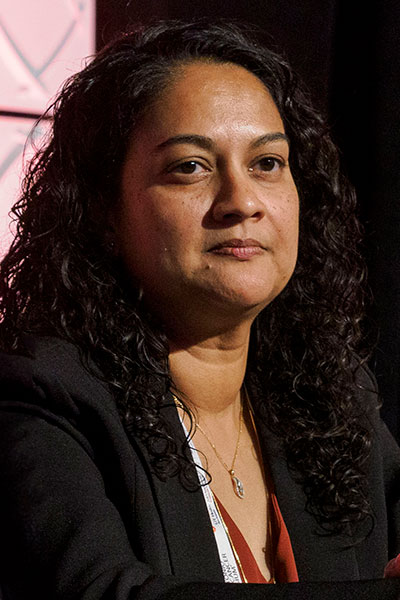The community where a person lives has a significant impact on that individual’s health outcomes.

“In many cases now, people are wondering if your ZIP code is almost as important as your genetic code because where you live, work, and play truly can impact your health,” said Amelie G. Ramirez, DrPH, MPH, UT Health Science Center at San Antonio.
Dr. Ramirez moderated Special Session 3: Social Determinants of Health: Impact on Cancer Care on the opening day of the 2023 SABCS®. The session is available on demand for registered Symposium participants through March 31, 2024, on the meeting platform.
“Our health is influenced by a variety of nonmedical health factors, such as conditions in which we are born, we grow, live and work, and age, and these are the conditions that are called social determinants of health (SDoH),” Dr. Ramirez explained. “It’s everything outside of the health domain, but what we’re finding is that these inequities in SDoH can create social needs that negatively impact our health.”

Health-related social needs encompass food insecurity, housing instability, transportation problems, utility assistance needs, and interpersonal safety, all of which are associated with adverse cancer outcomes, said Brenda A. Adjei, MPA, EdD, National Cancer Institute/Center for Cancer Research.
Research data show that up to 55 percent of patients with cancer experience food insecurity, and up to 17 percent experience housing instability, she reported. The prevalence of health-related social needs increases among patient populations already experiencing health disparities related to ethnicity, age, or other factors.
“Health equity in cancer care means that we ensure that everyone has a fair and just opportunity to prevent, detect, receive quality care, and survive cancer with optimal quality of life,” Dr. Adjei said.
SDoH screening and integrating social care into the delivery of health care at the clinician, organizational, and community levels can help ameliorate patient health and well-being.

“It’s just not one single factor that really drives these disparate outcomes,” said Brian M. Rivers, BS, MPH, PhD, Morehouse School of Medicine Cancer Health Equity Institute. “We know that there are contributions from the environmental space, the social, the cultural, the psychological, the clinical, the biological, the genetic, but then also the behavioral. The degree to which these different factors interact with one another is still being studied, but we know that it’s a multifactorial struggle, and anybody who wants to intervene on any of these disparate outcomes cannot only just address one of these factors, but they must address multiple factors.” This approach is outlined in the National Institute on Minority Health and Health Disparities Research Framework.
The U.S. Department of Health and Human Services estimates that 20 percent of health outcomes can be attributed to clinical care, while 50 percent of the county-level variation in patient outcomes is driven by SDoH.
To address SDoH, Dr. Rivers outlined a three-part strategy that includes recruiting local and national community partners, leveraging technology, and leveraging people, such as nurses, exercise coaches, social workers, and research coordinators.
SDoH screenings might include questions about such topics as alcohol use, tobacco use, financial resource strain, food insecurity, transportation needs, living arrangements, intimate partner violence, or post-partum depression, he said.
One successful approach to combatting food insecurity at a safety-net hospital in Atlanta was to replace the fast-food restaurant in the building with a “food pharmacy” where patients could be directed to obtain nutritious food.

Nutrition is a large, but solvable, social need among cancer patients, said Sandi L. Pruitt, PhD, UT Southwestern Medical Center.
During the COVID-19 pandemic, food shortages were pervasive across the United States, yet the overall national food security level in 2020 was the same as it was in 2019, before the start of the pandemic. This was the result of the political will to deploy existing food assistance programs nationwide, Dr. Pruitt contends.
“We can reduce the burden on everyone’s part, at multiple levels, and that requires political will and sustained policies and programs and innovative models to do this,” she said. “Leveraging community assets is critical, and I think that thinking about process mapping, or how we actually get these resources to people, and how time consuming it can really be, is a useful strategy for us to make things more efficient all around.”
Still, there are limits to current practices.

“There is not enough information to understand who, how, when to screen [for SDoH],” said Bárbara Segarra-Vázquez, DHSc, University of Puerto Rico-Medical Sciences Campus. “There are no standardized validation tools for cancer patients.”
Further complicating the barriers created by SDoH, health-related social needs are not static. The financial hardships of cancer treatment, for example, may result in food insecurity or housing instability that did not exist previously. Likewise, change in treatment could change a patient’s social needs.
“If I have chemo every three weeks, I might not have trouble with transportation, finding a neighbor or friend to take me,” said Dr. Segarra-Vázquez, a 20-year cancer survivor. “But when I had radiation therapy, I had to go Monday through Friday for seven weeks. It’s more difficult, and it could be different. So, if you screened me when I started my chemo, I might not have had a transportation need, but when I started my radiation treatment, I might.”

Health outcomes are the true measure of the impact of SDoH initiatives, said Susan T. Vadaparampil, PhD, MPH, Moffitt Cancer Center.
By addressing social service connections, housing, access to food, links to transportation, and care management and coordination at multiple levels, Dr. Vadaparampil said, the goal is for patients to experience fewer complication, fewer emergency and hospital admissions, fewer premature deaths, improved quality of health care, and increased satisfaction with care.
“If we don’t start with a baseline of measuring and being strategic about what we’re doing across all of these fronts, we are going to have a hard time figuring out what worked,” Dr. Vadaparampil said.

